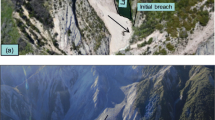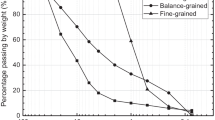Abstract
Natural dams are formed when landslides are triggered by heavy rainfall during extreme weather events in the mountainous areas of Taiwan. During landslide debris movement, two processes occur simultaneously: the movement of landslide debris from a slope onto the riverbed and the erosion of the debris under the action of high-velocity river flow. When the rate of landslide deposition in a river channel is higher than the rate of landslide debris erosion by the river flow, the landslide forms a natural dam by blocking the river channel. In this study, the effects of the rates of river flow erosion and landslide deposition (termed the erosive capacity and depositional capacity, respectively) on the formation of natural dams are quantified using a physics-based approach and are tested using a scaled physical model. We define a dimensionless velocity index vde as the ratio between the depositional capacity of landslide debris (vd) and the erosive capacity of water flow (ve). The experimental test results show that a landslide dam forms when landslide debris moves at high velocity into a river channel where the river-flow velocity is low, that is, the dimensionless velocity index vde > 54. Landslide debris will not have sufficient depositional capacity to block stream flow when the dimensionless velocity index vde < 47. The depositional capacity of a landslide can be determined from the slope angle and the friction of the sliding surface, while the erosive capacity of a dam can be determined using river flow velocity and rainfall conditions. The methodology described in this paper was applied to seven landslide dams that formed in Taiwan on 8 August 2009 during Typhoon Morakot, the Tangjiashan landslide dam case, and the Yingxiu-Wolong highway K24 landslide case. The dimensionless velocity index presented in this paper can be used before a rainstorm event occurs to determine if the formation of a landslide dam is possible.
Similar content being viewed by others
References
Casagli N, Ermini L, Rosati G (2003) Determining grain size distribution of the material composing landslide dams in the Northern Apennines: sampling and processing methods. Engineering Geology 69: 83–97. https://doi.org/10.1016/s0013-7952(02)00249-1
Chai H, Liu H, Zhang Z (1996) The main conditions of landslide dam. Journal of Geological Hazards and Environment Preservation 7(1): 41–46. (In Chinese)
Chen CY, Chang JM (2015) Landslide dam formation susceptibility analysis based on geomorphic features. Landslides 13: 1019–1033. https://doi.org/10.1007/s10346-015-0671-5
Chen KT, Chen XQ, Hu GS, et al. (2019a) Dimensionless assessment method of landslide dam formation caused by tributary debris flow events. Geofluids 2019 (Article ID 7083058). https://doi.org/10.1155/2019/7083058
Chen KT, Chen XQ, Niu ZP, Guo XJ (2019b) Early identification of river blocking induced by tributary debris flow based on dimensionless volume index. Landslides. https://doi.org/10.1007/s10346-019-01221-8
Chen KT, Kuo YS, Shieh CL (2014) Rapid geometry analysis for earthquake-induced and rainfall-induced landslide dams in Taiwan. Journal of Mountain Science 11: 360–370. https://doi.org/10.1007/s11629-013-2664-y
Chen KT, Lin CH, Chen XQ, et al. (2018a) An assessment method for debris flow dam formation in Taiwan. Earth Sciences Research Journal 22: 37–43. https://doi.org/10.15446/esrj.v22n1.62389
Chen KT, Wu JH (2018b) Simulating the failure process of the Xinmo landslide using discontinuous deformation analysis. Engineering Geology 239: 269–281. https://doi.org/10.1016/j.enggeo.2018.04.002
Chen XQ, Cui P, Li Y, Zhao WY (2011) Emergency response to the Tangjiashan landslide-dammed lake resulting from the 2008 Wenchuan Earthquake, China. Landslides 11: 91–98. https://doi.org/10.1007/s10346-010-0236-6
Cheng ZL, Wu JS, Geng XY (2005) Debris flow dam formation in southeast Tibet. Journal of Mountain Science 2(2): 155–163. https://doi.org/10.1007/bf02918331
Chubu Regional Construction Bureau (1987) Case studies of natural dam in Japan. Research Report of Chubu Regional Construction Bureau. Ministry of Construction, Japan. (In Japanese)
Ciampalini A, Raspini F, Lagomarsino D, et al. (2016) Landslide susceptibility map refinement using PSInSAR data. Remote Sensing of Environment 184: 302–315. https://doi.org/10.1016/j.rse.2016.07.018
Copons R, Vilaplana JM, Linares R (2009) Rockfall travel distance analysis by using empirical models (Solà d’Andorra la Vella, Central Pyrenees). Natural Hazards and Earth System Sciences 9: 2107–2118. https://doi.org/10.5194/nhess-9-2107-2009
Corominas J (1996) The angle of reach as a mobility index for small and large landslides. Canadian Geotechnical Journal 33: 260–271. https://doi.org/10.1139/t96-005
Costa JE, Schuster RL (1988) The formation and failure of natural dams. Geological Society of America Bulletin 100: 1054–1068. https://doi.org/10.1130/0016-7606(1988)100<1054:TFAFON>2.3.CO;2
D’Agostino V, Cesca M, Marchi L (2010) Field and laboratory investigations of runout distances of debris flows in the Dolomites (Eastern Italian Alps). Geomorphology 115: 294–304. https://doi.org/10.1016/j.geomorph.2009.06.032
Dal Sasso SF, Sole A, Pascale S, et al. (2014) Assessment methodology for the prediction of landslide dam hazard. Natural Hazards and Earth System Sciences 14: 557–567. https://doi.org/10.5194/nhessd-1-5663-2013
Dalla Fontana G, Marchi L (2003) Slope-area relationships and sediment dynamics in two alpine streams. Hydrological Processes 17: 73–87. https://doi.org/10.1002/hyp.1115
Ding WT, Xu WJ (2018) Study on the multiphase fluid-solid interaction in granular materials based on an LBM-DEM coupled method. Powder Technology 335: 301–314. https://doi.org/10.1016/j.powtec.2018.05.006
Dong JJ, Lai PJ, Chang CP, et al. (2014) Deriving landslide dam geometry from remote sensing images for the rapid assessment of critical parameters related to dam-breach hazards. Landslides 11: 93–105. https://doi.org/10.1007/s10346-012-0375-z
Dong JJ, Li YS, Kuo CY, et al. (2011) The formation and breach of a short-lived landslide dam at Hsiaolin village, Taiwan—Part I: Post-event reconstruction of dam geometry. Engineering Geology 123: 40–59. https://doi.org/10.1016/j.enggeo.2011.04.001
Du C, Yao LK, Shakya S, et al. (2014) Damming of large river by debris flow: Dynamic process and particle composition. Journal of Mountain Science 11: 634–643. https://doi.org/10.1007/s11629-012-2568-2
Ermini L, Casagli N (2003) Prediction of the behaviour of landslide dams using a geomorphological dimensionless index. Earth Surface Processes and Landforms 28: 31–47. https://doi.org/10.1002/esp.424
Fan XM, Rossiter DG, Westen CJV, et al. (2014) Empirical prediction of coseismic landslide dam formation. Earth Surface Processes and Landforms 39: 1913–1926. https://doi.org/10.1002/esp.3585
Fan XM, van Westen CJ, Xu Q, et al. (2012) Analysis of landslide dams induced by the 2008 Wenchuan earthquake. Journal of Asian Earth Sciences 57: 25–37. https://doi.org/10.1016/j.jseaes.2012.06.002
Finlay PJ, Mostyn GR, Fell R (1999) Landslide risk assessment: prediction of travel distance. Canadian Geotechnical Journal 36: 556–562. https://doi.org/10.1139/cgj-36-3-556
Forestry Bureau (2010) Investigations and strategy for hazard mitigation of the Namasha and Shih-Wun landslide dam. Research Report of Forestry Bureau. Council of Agriculture, Executive Yuan, Taipei, Taiwan. (In Chinese)
Guo D, Hamada M, He C, et al. (2014) An empirical model for landslide travel distance prediction in Wenchuan earthquake area. Landslides 11: 281–291. https://doi.org/10.1007/s10346-013-0444-y
Guzzetti F, Ardizzone F, Cardinali M, et al. (2009) Landslide volumes and landslide mobilization rates in Umbria, central Italy. Earth and Planetary Science Letters 279: 222–229. https://doi.org/10.1016/j.epsl.2009.01.005
Hsu JPC, Capart H (2008) Onset and growth of tributary-dammed lakes. Water Resources Research 44(11). https://doi.org/10.1029/2008WR007020
Hungr O (1995) A model for the runout analysis of rapid flow slides, debris flows and avalanches. Canadian Geotechnical Journal 32: 610–623. https://doi.org/10.1139/t95-063
Hutter K, Koch T, Pluss C, et al. (1995) The dynamics of avalanches of granular materials from initiation to runout. Part II. Experiments. Acta Mechanica 109: 127–165. https://doi.org/10.1007/bf01176820
Korup O (2004) Geomorphometric characteristics of New Zealand landslide dams. Engineering Geology 73: 13–35. https://doi.org/10.1016/j.enggeo.2003.11.003
Korup O, Strom AL, Weidinger JT (2006) Fluvial response to large rock-slope failures: Examples from the Himalayas, the Tien Shan, and the Southern Alps in New Zealand. Geomorphology 78: 3–21. https://doi.org/10.1016/j.geomorph.2006.01.020
Kuo YS, Tsai YJ, Chen YS, et al. (2013) Movement of deep-seated rainfall-induced landslide at Hsiaolin Village during Typhoon Morakot. Landslides 10: 191–202. https://doi.org/10.1007/s10346-012-0315-y
Kuo YS, Tsang YC, Chen KT, et al. (2011) Analysis of landslide dam geometries. Journal of Mountain Science 8: 544–550. https://doi.org/10.1007/s11629-011-2128-1
Lee SP, Chen YC, Shieh CL, et al. (2013) Using real-time abnormal hydrology observations to identify a river blockage event resulted from a natural dam. Landslides 11: 1007–1017. https://doi.org/10.1007/s10346-013-0441-1
Liu CY (2015) Mechanism Analysis for Yingxiu-Wolong Highway K24 Landslide. MD thesis, Southwest Jiaotong University, Chengdu, China. p 10–33.
Liu N, Cheng ZL, Cui P, et al. (2013) Dammed Lake and Risk Management. Science Press, Beijing, China. (In Chinese)
Manzella I, Labiouse V (2013) Empirical and analytical analyses of laboratory granular flows to investigate rock avalanche propagation. Landslides 10: 23–36. https://doi.org/10.1007/s10346-011-0313-5
Mori T, Sakaguchi T, Inoue K (2011) Countermeasure for natural dam in Japan. Kokonshoin, Tokyo, Japan. (In Japanese)
Nakagawa H, Tsujimoto T (1975) Study on mechanism of motion of individual sediment particles. Proceedings of the Japan Society of Civil Engineers 244: 71–80. (In Japanese)
Okura Y, Kitahara H, Kawanami A, et al. (2003) Topography and volume effects on travel distance of surface failure. Engineering Geology 67: 243–254. https://doi.org/10.1016/s0013-7952(00)00049-1
Peng M, Zhang LM (2012) Breaching parameters of landslide dams. Landslides 9: 13–31. https://doi.org/10.1007/s10346-011-0271-y
Scheidegger AE (1973) On the prediction of the reach and velocity of catastrophic landslides. Rock Mechanics and Rock Engineering 5(4): 231–236. https://doi.org/10.1007/BF01301796
Shrestha BB, Nakagawa H (2016) Hazard assessment of the formation and failure of the Sunkoshi landslide dam in Nepal. Natural Hazards 82: 2029–2049. https://doi.org/10.1007/s11069-016-2283-3
Soil and Water Conservation Bureau (2011) The reconstruction of the processes of compound disasters caused by the 2009 Typhoon Morakot. Research Report of Soil and Water Conservation Bureau. Council of Agriculture, Executive Yuan, Nantou, Taiwan. (In Chinese)
Song YX, Huang D, Cen DF (2016) Numerical modelling of the 2008 Wenchuan earthquake-triggered Daguangbao landslide using a velocity and displacement dependent friction law. Engineering Geology 215: 50–68. https://doi.org/10.1016/j.enggeo.2016.11.003
Tabata S, Mizuyama T, Inoue K (2002) Natural Landslide Dams Hazards. Kokonshoin, Tokyo, Japan. (In Japanese)
Tacconi Stefanelli C, Segoni S, Casagli N, et al. (2016) Geomorphic indexing of landslide dams evolution. Engineering Geology 208: 1–10. https://doi.org/10.1016/j.enggeo.2016.04.024
Takahashi T, Kuang SF (1988) Hydrograph prediction of debris flow due to failure of landslide dam. Disaster Prevention Research Institute Annals 31: 601–615. (In Japanese)
Tseng CM, Lin CW, Stark CP, et al. (2013) Application of a multi-temporal, LiDAR-derived, digital terrain model in a landslide-volume estimation. Earth Surface Processes and Landforms 38(13): 1587–1601. https://doi.org/10.1002/esp.3454
Wang W, Zhang H, Zheng L, et al. (2017) A new approach for modeling landslide movement over 3D topography using 3D discontinuous deformation analysis. Computers and Geotechnics 81: 87–97. https://doi.org/10.1016/j.compgeo.2016.07.015
Water Resources Agency (2009) The analysis of the rainfall and river discharge during Typhoon Morakot. Research Report of Water Resources Agency. Ministry of Economic Affairs, Taipei, Taiwan (In Chinese)
Xu WJ, Xu Q, Wang YJ (2013) The mechanism of high-speed motion and damming of the Tangjiashan landslide. Engineering Geology 157: 8–20. https://doi.org/10.1016/j.enggeo.2013.01.020
Yan J, Cao ZX, Liu HH, et al. (2009) Experimental study of landslide dam-break flood over erodible bed in open channels. Journal of Hydrodynamics 21: 124–130. https://doi.org/10.1016/S1001-6058(08)60127-4
Yang Y, Cao SY, Yang KJ, et al. (2015) Experimental study of breach process of landslide dams by overtopping and its initiation mechanisms. Journal of Hydrodynamics 27: 872–883. https://doi.org/10.1016/S1001-6058(15)60550-9
Zhao T, Dai F, Xu NW (2017) Coupled DEM-CFD investigation on the formation of landslide dams in narrow rivers. Landslides 14: 189–201. https://doi.org/10.1007/s10346-015-0675-1
Zhou C, Yin K, Cao Y, et al. (2018) Landslide susceptibility modeling applying machine learning methods: A case study from Longju in the Three Gorges Reservoir area, China. Computers & Geosciences 112: 23–37. https://doi.org/10.1016/j.cageo.2017.11.019
Zhou GGD, Cui P, Chen HY et al. (2013) Experimental study on cascading landslide dam failures by upstream flows. Landslides 10: 633–643. https://doi.org/10.1007/s10346-012-0352-6
Zhou M, Zhou GGD, Cui KFE, et al. (2019) Influence of inflow discharge and bed erodibility on outburst flood of landslide dam. Journal of Mountain Science 16(4): 778–792. https://doi.org/10.1007/s11629-018-5312-8
Acknowledgements
We thank three anonymous reviewers for constructive comments on an earlier version of this manuscript. This research was supported by the National Natural Science Foundation of China (Grants No. 41661144028, 41771045 and 41501012), the CAS “Light of West China” Program, the Foundation for Young Scientist of Institute of Mountain Hazards and Environment, CAS (Grant No. SDS-QN-1912) and the Foundation of Youth Innovation Promotion Association, CAS (Grant No. 2017425).
Author information
Authors and Affiliations
Corresponding author
Rights and permissions
About this article
Cite this article
Chen, KT., Chen, XQ., Hu, GS. et al. Effects of river flow velocity on the formation of landslide dams. J. Mt. Sci. 16, 2502–2518 (2019). https://doi.org/10.1007/s11629-018-5319-1
Received:
Revised:
Accepted:
Published:
Issue Date:
DOI: https://doi.org/10.1007/s11629-018-5319-1




